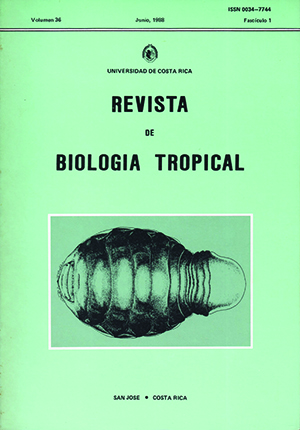Abstract
Some aspects on the biology of the mud shrimp. Upogebia dawsoni from the Requeson mangrove area, whithin Bahia Concepcion, and Mulege river estuary, Mulege (Baja California Sur, México) are described. Collections of U. dawsoni were done in January (winter), March (Spring) and July (Summer) in 1986 at Requeson, and in October (Fall) of 1985 and June (summer) of 1986, at Mulege. A total of 280 individuals were collected between 0.40 and 1.0 m in depth. Size, sex ratio, spawning period, egg number, stomach contents and external morphology were recorded. A seasonal comparative analysis between the two localities showed that the specimens from Requeson had greater lengths. In Summer, females represented 6.67% and juveniles 93.33% while in Fall, females represented 93.27%, males 3.58%, juveniles 2.25%, and ovigerous females, stage II 0.90% at Mulege. In Winter, females comprised 30.76%, at Requeson. Two spawning periods were detected, one in Fall (Mulege), and other in Summer (Requeson). The largest female (total length= 28.0 mm) carried out 2133 eggs and the shortest one (total length = 11.0 mm) had 119 eggs. Sediment, leaves and roots of mangrove, insect wings, diatoms, dinoflagellates bacteria, and sponge spicules were found in the stomachs.
References
Antezana, T., E. Fagetti & M.T. López. 1965. Observaciones ecológicas de decápodos comunes de Valparaíso. Rev. Biol. Mar. 12: 1-60.
Brusca, C.R. & B.R. Wallersterin. 1979. Zoogeographic patterns of idoteid isopods in the northeast Pacific, with a review of shallow water Zoogeography of the area. Bull. Biol. Soc. Wash. 3: 67-105.
Pearse, A.S. 1945. Ecology of Upogebia affinis (Say). Ecology, 26: 303-305.
Pena, N.J.M. & R. Habib. 1980. La Técnica Microhistológica. Un método para determinar la composición botánica de la dieta de herbívoros. Ser. Tec. Cienc. INIP. 1: 1-82.
Thistle, D. 1973. A taxonomic comparison of the American Upogebia (Decapoda, Thalassinoidea), including two new species from the Caribbean. Breaviora, Mus. Comp. Zool. 408: 1-23.
Turrubiates, M.J.R. & R. González. 1985. Descripción de las dos primeras zoeas, obtenidas en el laboratorio de Upogebia pugettensis (Dana) (Crustacea: Decapoda: Callianasidae) de la Ensenada de la Paz, B.C.S., México. Inv. Mar. CICIMAR, 2: 103-112.
Williams, B.A. 1986. Mud shrimps, Upogebia from the eastern Pacific (Thalassinoidea: Upogebiidae). Trans. Sn Diego Nat. Hist. Soc. 14: 1-60.
##plugins.facebook.comentarios##

This work is licensed under a Creative Commons Attribution 4.0 International License.
Copyright (c) 1988 Revista de Biología Tropical


